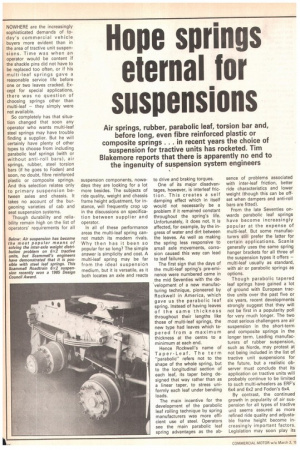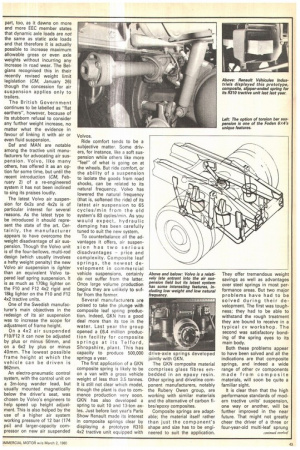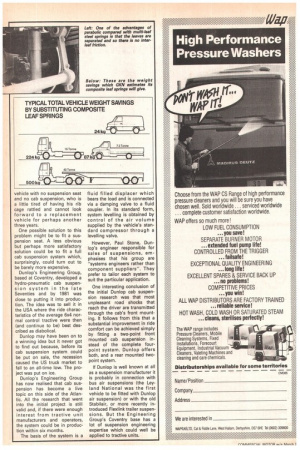ope springs eternal for suspensions
Page 44

Page 45

Page 46

If you've noticed an error in this article please click here to report it so we can fix it.
Air springs, rubber, parabolic leaf, torsion bar and, before long, even fibre reinforced plastic or composite springs . . . in recent years the choice of suspension for tractive units has rocketed. Tim Blakemore reports that there is apparently no end to the ingenuity of suspension system engineers
NOWHERE are the increasingly sophisticated demands of today's commercial vehicle buyers more evident than in the area of tractive unit suspensions. Time was when an operator would be content if the shackle pins did not have to be replaced too often, or if his multi-leaf springs gave a reasonable service life before one or two leaves cracked. Except for special applications, there was no question of choosing springs other than multi-leaf — they simply were not available.
So completely has that situation changed that soon any operator who wants multi-leaf steel springs may have trouble finding a supplier. But he will certainly have plenty of other types to choose from including parabolic leaf springs (with or without anti-roll bars), air springs, rubber, steel torsion bars (if he goes to Foden) and soon, no doubt, fibre reinforced plastic or composite springs. And this selection relates only to primary suspension between axles and chassis. It takes no account of the burgeoning varieties of cab and seat suspension systems.
Though durability and reliability remain high on the list of operators' requirements for all suspension components, nowadays they are looking for a lot more besides. The subjects of ride quality, weight and chassis frame height adjustment, for instance, will frequently crop up in the discussions on specification between supplier and operator.
In all of these performance areas the multi-leaf spring cannot match its modern rivals. Why then has it been so popular for so long? The simple answer is simplicity and cost. A multi-leaf spring may be far from the ideal suspension medium, but it is versatile, as it both locates an axle and reacts to drive and braking torques.
One of its major disadvantages, however, is interleaf friction. This creates a self damping effect which in itself would not necessarily be a problem if it remained constant throughout the spring's life. Unfortunately, it does not. It is affected, for example, by the ingress of water and dirt between the leaves. As well as making the spring less responsive to small axle movements, corrosion caused this way can lead to leaf failures.
The first sign that the days of the multi-leaf spring's pre-eminence were numbered came in .the mid Seventies with the development of a new manufacturing technique, pioneered by Rockwell in America, which gave us the parabolic leaf spring. Instead of having leaves of the same thickness throughout their lengths like those of multi-leaf springs, the new type had leaves which tapered from a maximum thickness at the centre to a minimum at each end.
Hence Rockwell's name of Taper-Leaf. The term "parabolic" refers not to the shape of the whole spring, but to the longitudinal section of each leaf, its taper being designed that way rather than as a linear taper, to stress uniformly each leaf under bending loads.
The main incentive for the development of the parabolic leaf rolling technique by spring manufacturers was more efficient use of steel. Operators see the main parabolic leaf spring advantages as the ab sence of problems associated with inter-leaf friction, better ride characteristics and lower weight (though this can be offset when dampers and anti-roll bars are fitted).
From the late Seventies onwards parabolic leaf springs have become increasingly popular at the expense of multi-leaf. But some manufacturers still prefer the latter for certain applications. Scania generally uses the same spring hanger brackets for all three of the suspension types it offers — multi-leaf usually as standard, with air or parabolic springs as options.
Though parabolic tapered leaf springs have gained a lot of ground with European tractive units over the past five or six years, recent developments strongly suggest that they will not be first in a popularity poll for very much longer. The two most serious challengers are air suspension in the short-term and composite springs in the longer term. Leading manufacturers of rubber suspension, such as Norde, may protest at not being included in the list of tractive unit suspensions for the future, but a realistic observer must conclude that its application on tractive units will probably continue to be limited to such multi-wheelers as ERF's 6x4 and 6x2 and Foden's 6x4.
By contrast, the continued growth in popularity of air suspension for all types of tractive unit seems assured as more refined ride quality and adjustable frame height become increasingly important factors. Legislation may soon play its part, too, as it dawns on more and more EEC member states that dynamic axle loads are not the same as static axle loads and that therefore it is actually possible to increase maximum allowable gross or even axle weights without incurring any increase in road wear. The Belgians recognised this in their recently revised weight limit legislation (CM, January 26) though the concession for air suspension applies only to trailers.
The British Government continues to be labelled as "flat earthers", however, because of its stubborn refusal to consider any further weight increase, no matter what the evidence in favour of linking it with air or even fluid suspension.
Daf and MAN are notable among the tractive unit manufacturers for advocating air suspension. Volvo, like many others, has offered it as an option for some time, but until the recent introduction (CM, February 2) of a re-engineered system it has not been inclined to sing its praises loudly.
The latest Volvo air suspension for 6x2s and 4x2s is of particular interest for several reasons. As the latest type to be introduced it should represent the state of the art. Certainly, the manufacturer appears to have overcome the weight disadvantage of air suspension. Though the Volvo unit is of the four-bellows, multi-rod design (which usually involves a hefty weight penalty) the new Volvo air suspension is lighter than an equivalent Volvo tapered leaf spring suspension. It is as much as 170kg lighter on the F10 and F12 4x2 rigid and 18kg lighter on the F10 and F12 4x2 tractive units.
One of the Swedish manufacturer's main objectives in the redesign of its air suspension was to increase the scope for adjustment of frame height.
On a 4x2 air suspended F10/F12 it can now be adjusted by plus or minus 50mm, and on a 6x2 by plus or minus 40mm. The lowest possible frame height at which the vehicle can be driven is 962mm.
An electro-pneumatic control system, with the control unit on a 3m-long wander lead, but usually mounted magnetically below the driver's seat, was chosen by Volvo's engineers to help speed up height adjustment. This is also helped by the use of a higher air system working pressure of 12 bar (174 psi) and larger-capacity compressor on new air suspended Volvos.
Ride comfort tends to be a subjective matter. Some drivers, for instance, like a soft suspension while others like more "feel" of what is going on at the wheels. But ride comfort, or the ability of a suspension to isolate the goods from road shocks, can be related to its natural frequency. Volvo has lowered the natural frequency (that is, softened the ride) of its latest air suspension to 65 cycles/min from the old system's 83 cycles/min. As you would expect, hydraulic damping has been carefully tuned to suit the new system.
To counterbalance all the advantages it offers, air suspension has two serious disadvantages -price and complexity. Composite leaf springs, the newest development in commercial vehicle suspensions, certainly do not suffer from the latter. Once large volume production begins they are unlikely to suffer from the former.
Several manufacturers are poised to take the plunge with composite leaf spring production. Indeed, GKN has a good deal more than its toe in the water. Last year the group opened a E6.4 million production facility for composite springs at its Telford, Shropshire, plant. This has capacity to produce 500,000 springs a year.
The first application of a GKN composite spring is likely to be on a van with a gross vehicle weight of less than 3.5 tonnes. It is still not clear which model, though the plant is due to commence production very soon. GKN has also developed a spring to suit 10 and 13-ton axles. Just before last year's Paris Show Renault made its interest in composite springs clear by displaying a prototype R310 4x2 tractive unit equipped with drive-axle springs developed ointly with GKN.
The GKN composite material comprises glass fibres embedded in an epoxy resin. Other spring and driveline component manufacturers, notably the Rubery Owen group, are working with similar materials and the alternative of carbon fibre/epoxy composites.
Composite springs are adaptable; the material itself rather than just the component's shape and size has to be engineered to suit the application. They offer tremendous weight savings as well as advantages over steel springs in most performance areas. But two major problems have had to be solved during their development. The first was toughness; they had to be able to withstand the rough treatment they are bound to receive in a typical cv workshop. The second was satisfactory bonding of the spring eyes to its main body.
Both these problems appear to have been solved and all the indications are that composite springs, and indeed a wide range of other cv components made from composite materials, will soon be quite a familiar sight.
It is clear then that the high performance standards of modern tractive units' suspension, one way or another, will be further improved in the near future. That might not greatly cheer the driver of a three or four-year-old multi-leaf sprung vehicle with no suspension seat and no cab suspension, who is a little tired of having his rib cage rattled and cannot look forward to a replacement vehicle for perhaps another three years.
One possible solution to this problem might be to fit a suspension seat. A less obvious but perhaps more satisfactory solution could be to fit a full cab suspension system which, surprisingly, could turn out to be barely more expensive.
Dunlop's Engineering Group, based at Coventry, developed a hydro-pneumatic cab suspension system in the late Seventies and by 1981 was close to putting it into production. The idea was to sell it in the USA where the ride characteristics of the average 6x4 normal control tractive were then (and continue to be) best described as diabolical.
Dunlop may have been on to a winning idea but it never got to find out because, before its cab suspension system could be put on sale, the recession caused the US truck market to fall to an all-time low. The project was put on ice.
Dunlop's Engineering Group has now realised that cab suspension has become a live topic on this side of the Atlantic. All the research that went into the initial project is still valid and, if there were enough interest from tractive unit manufacturers and operators, the system could be in production within six months.
The basis of the system is a fluid filled displacer which bears the load and is connected via a damping valve to a fluid coupler. In its standard form, system levelling is obtained by control of the air volume supplied by the vehicle's standard compressor through a levelling valve.
However, Paul Stone, Dunlop's engineer responsible for sales of suspensions, emphasises that his group are "systems engineers rather than component suppliers". They prefer to tailor each system to suit the particular application.
One interesting conclusion of the initial Dunlop cab suspension research was that most unpleasant road shocks that reach the driver are transmitted through the cab's front mounting. It follows from this that a substantial improvement in ride comfort can be achieved simply by fitting a two-point front mounted cab suspension instead of the complete fourpoint system. Dunlop offers both, and a rear mounted twopoint system.
If Dunlop is well known at all as a suspension manufacturer it is probably in connection with bus air suspensions (the Leyland National was the first vehicle to be fitted with Dunlop air suspension) or with the old Stabilair, or more recently introduced Flexlink trailer suspensions. But the Engineering Group's Coventry base has a lot of suspension engineering expertise which could well be applied to tractive units.
























































































